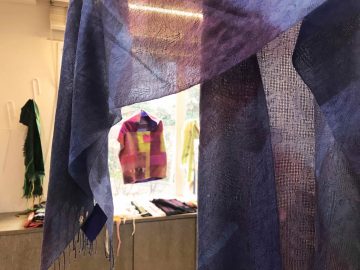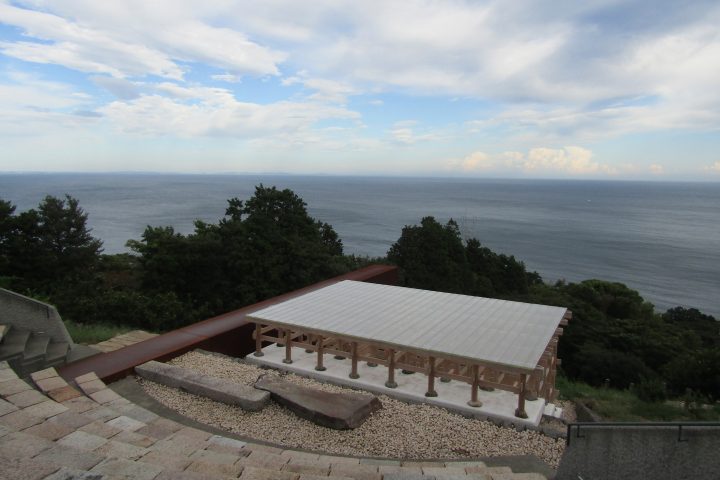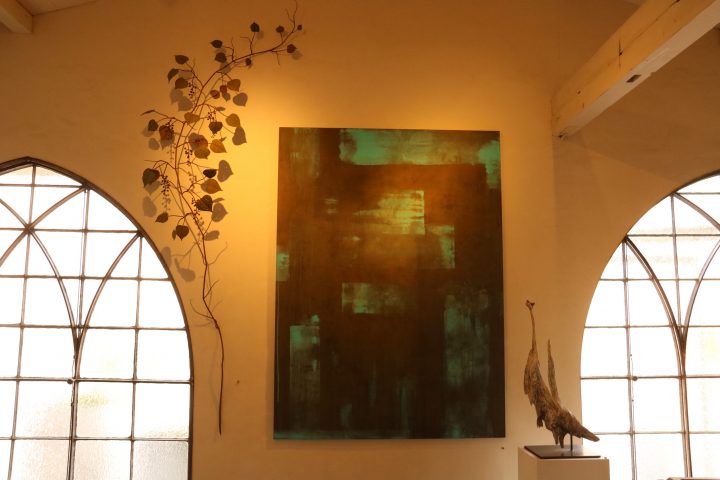Yokohama Triennale 2014: Interview with Emiko Kasahara

Interview: Haruo Kobayashi (blanClass)
Text: Akiko Inoue
Photo: Masamasa Nishino
In early July, just before the Yokohama Triennale 2014 (hereafter referred to as Yokohama Triennale 2014) was held, we interviewed the artist Emiko Kasahara at the alternative space blanClass in Idogaya, Minami-ku, Yokohama. The interviewer was Haruo Kobayashi, the director of blanClass and an artist. Kasahara was an instructor at B-Zemi (a contemporary art learning system) , the predecessor of blanClass, from the late 1990s to the early 2000s, and is an old friend of Kobayashi. Kasahara, who could not hide her nostalgia for the interview at her old home, spoke to us about her work "OFFERING", which she is exhibiting at this exhibition. This project "OFFERING", which took an enormous amount of time to create (and is still not completed), could be said to have been made possible by a continuing journey to explore a certain issue that is important to Kasahara (and by extension, to us). Coincidentally, the theme of Yokohama Triennale 2014 is also "An Adventurous Journey into the Sea of Oblivion." I hope that through this interview you will learn about the process of long-term exploration that was driven by a single aesthetic experience, and that it will serve as an opportunity to encounter works at the Yokohama Triennale 2014 venue. Let's move on to the main part of the article.
The story behind the creation of "OFFERING"
Kobayashi: Since you will be exhibiting at Yokohama Triennale 2014, I would like to ask you more about your work "OFFERING."
Kasahara : This work is a series of projects called Offering, which consists of photographic works and three-dimensional works. In terms of media, it is photography and three-dimensional works, but in other words, it is a photographic work that captures real things in the world as a document, and a sculpture that I created as art. For me, it was very important to combine the two elements of documentary and my own creation. Another characteristic is that it took a very long time, about 10 years, to create this work. Since this project started because I was interested in a huge amount of things, it took a very long time to record it in photographs. In terms of the time axis, I think it is unique among my previous works.
Kobayashi: What kind of work is it specifically?
Kasahara : To explain the background, I used to go to Italy frequently in the late 90s. I was in Tuscany, so I had a few opportunities to go to Pisa, which is close by. In the square with the famous leaning tower, there is a baptistery (a building attached to a church for baptism) and a Duomo (a church), and I went to see these buildings. Then, one rainy day, I entered the baptistery. It is a cylindrical building, and inside, all the decorative paintings and busts are on the walls, and there is only an octagonal baptismal font in the center like a recess in the building, and the entire space of the building seems to be open. In that empty space, there was a waist-high sculpture standing alone. The moment I saw it, I had a sense that it had some important meaning. I wondered what it was, so I went closer and saw that it was a beautiful wooden box that had been carefully and minimally made, and that box was the prototype for this work. This is a piece of art I created, which is faithful to the box I saw at the time.
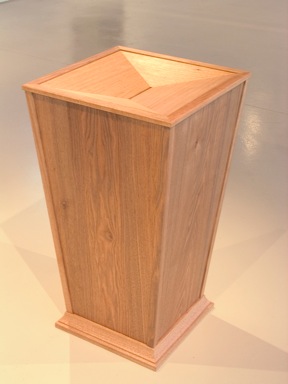
"Offering - Monica"
Kobayashi: It was made of wood, wasn't it?
Kasahara : Yes. I used wood of a similar color in my work. I approached and looked at the top of the box, and noticed a slit in the middle. Just then, an old woman approached from behind and dropped some money into the slit. That's when I realized for the first time that this was a donation box. There was a donation box in the center of the building, and it was an object with a feminine shape and perfect beauty. Furthermore, by chance, an old woman came by and put some money in it... All of this remained in my mind as an aesthetic experience for a long time. When I had the opportunity to return to that place again after some time, I took a photo and measured the size without worrying about what other people thought. I wanted to find out what this feeling was. This was the beginning of this project.
Kobayashi: When did you first visit?
Kasahara : I think it was around 1998.
Kobayashi: The second time?
Kasahara : Around 2001, I think.
The ideology underlying Western-centric values: A journey following the footsteps of the spread of Christianity
Kasahara : We live in Japan, a non-Western country, and we have conversations in society about how much Western values we should adopt, for example, how currency is used, how political conversations are held, and even in museum systems and school education. Whether consciously or unconsciously, I think this can be said. And I believe that the fundamental idea that creates those Western values is Christianity. If you think about the ideology that is at the very base of Christianity, it is "Devotion". Devotion originally means that I will give you everything but do not ask for anything in return, and the system of "Offering" was born as a way to symbolize this Devotion. The idea of Devotion, which was originally a lofty ideology, was transformed into money and things that are considered very secular. In other words, it is a system in which the sacred and the secular can coexist side by side, and I interpret this as an offering.
Christianity, which started as a small event in the Middle East, was persecuted, divided, traveled to Europe, and spread around the world with colonialism. I think it was a process of universalizing a certain system that went beyond religious evangelism. I thought it was necessary for me to travel and experience that process myself. Although it took time to discover and record the objects and donation boxes actually used in the offerings, it was the process of carefully thinking about and developing the project, and I think it was very important and effective.
Kobayashi: I see. Other symbolic things have also spread along with Christianity, such as idols and sculptures.
Kasahara : That's right.
Putting something in a box or receiving something in a plate is also very symbolic. Passive shapes like boxes and plates are also feminine shapes. In fact, all of the sculptures in OFFERING are named after saints. Thinking about it, I didn't realize it, but it may be related to the feminine sculptures I made in the past.
Kobayashi: What I find interesting is that vessels are also a system in themselves. They are completely different from paintings or sculptures that are more superficially majestic and sublimely presented. They are the default within the so-called system, and I get the feeling that they are focusing on something that is visible but not seen.
Kasahara : That's right.
Kobayashi: Is it different from a (Japanese) offering box?
Kasahara : The system is the same. However, in this work, I wanted to limit myself to Christian offerings and their background. This is because it was clearly looking at an overwhelmingly Western-centric worldview. By focusing on one thing, I wanted to clarify the perspective that emerged, so I did not touch on other religions.
Kobayashi: It may be a very conceptual system, but the system of donation boxes is designed in a way that makes the idea of giving and receiving (giving something and receiving in return) that is present in Christianity not seem too blatant.
Kasahara : Well, it's hypocrisy. It's something that exists in other religions and systems, but considering that we have a Western-centric society with Christianity as its backbone, looking at the hypocrisy of offerings was very meaningful for me.

Kobayashi: What about the 10 years of research that took place? What was the process?
Kasahara : Christianity began in the Middle East, then dispersed to Egypt, Syria, and Europe, before spreading as a Western religion to America, Africa, Asia, and Oceania. It has traveled around the world while changing shape throughout history. This was the guiding principle for my work, so I was determined to travel around all five continents! Of course it took time, though.
Kobayashi: Even though you didn't know what to expect at first, you thought, "I'll just start watching it!" What made you so confident?
Kasahara : I didn't feel that way at the beginning, but around the second year. I thought I should look into it more, that it wouldn't end easily. In fact, I thought it was dealing with something that would never end, and that if I kept on doing it, I could do it until I died, so I made it with that in mind.
Things continue, so it's just a matter of where and how far you cut them out. When I want to see something that is certainly connected, even though it has jumped over time and place, I really don't want to focus on one local point. As a result, I try to follow as many points as possible and look at various aspects. But in the end, those many points clearly lead to the same values. That is proof of the truth of how homogenous the world is, even in terms of ideas. There is a saying that pop culture makes the world homogenous, but I think that this is not limited to pop culture, but is the nature of culture. I think that this has always happened when people have communicated something. There is a cathartic moment when something unknown is communicated, but the moment it is communicated, far from being cathartic, a very mediocre world appears, and as a result of these things happening repeatedly, ultimately a flat horizon of values is born... I think that's what it is. However, there are various reasons and circumstances behind that flat and uniform-looking horizon. I think the question is how to look at this properly.
One thing I want to say is that this project is not about religion per se. I'm often asked this question, but I'm not a Christian, I'm an atheist.
Kobayashi: That's also reflected in the shape. The cut-out parts don't look like that.
"Documentation" and "creative work" - Incorporating two elements into a work
Kobayashi: Why did you decide to actually create something yourself, rather than just documenting it?
Kasahara : Hmm... I think the act of turning it into a work of art is artistic courage. The real donation box has an overwhelming strength that is different from the one made in the studio, and I always feel guilty about documenting it. After all, I hate the idea of simply talking about beauty or the quality of a work, separating the political, historical, and economic issues that are actually happening from the context of art. Taking these feelings into account, I bring reality closer to the work, and the work also moves closer to reality. By taking this approach to production, I think it will clearly no longer be just a document, and it will no longer be an art piece that is only based on aesthetics.
Kobayashi: In your work up until now, I have felt that even if something has been very simply separated, by juxtaposing the two pieces, or by connecting them, the thing in the middle becomes more apparent. Is it then necessary for you to "turn it into a work of art" as you just mentioned?
Kasahara : That's right. When we talk about things, we tend to ask whether they are black or white. But when there is both black and white, how do we talk about things that are neither black nor white? That's something that's not often said. But I think that this is actually the essence of things. That's why I want to do that in art.
Kobayashi: Making such a dichotomy is based on prejudice, and while it's simple, it's also unreasonable.
Kasahara : Yes. Dualism also comes from Christian values. It's a very Western way of thinking.
On "Forgetting" - What can only be seen through artistic values?
Kobayashi: Next I'd like to move on to the topic of "forgetfulness," which is one of the keywords for Yokohama Triennale 2014. I think what you've just said is somehow connected to artistic director Morimura Yasumasa's idea of "things that have been forgotten in our information society." In terms of your participation in Yokohama Triennale 2014, what relationship do you see between this and your work?
Kasahara : As for this work, Morimura may have interpreted it as something that has been forgotten in the sense that it deals with a donation box, which was made by an overwhelmingly anonymous group, and is so commonplace that no one consciously notices it, even though it is there. For me, forgetting is a kind of strategy, and I sympathize to some extent with the value of remaining anonymous and hiding without belonging to anywhere, and I have a strong sense of surviving by maintaining one's identity while blending in with the general public.
Regarding the interpretation of forgetting, I would like to give one example of a case that is easily misunderstood. In 2001, the year of the terrorist attacks at the World Trade Center, I participated in the first Yokohama Triennale. On my way back to New York after the exhibition ended, I happened to stop by Los Angeles, and the attacks occurred the next day. A few days later, I was finally able to return to New York, and the domestic flight I took was extremely tense. The plane circled just above the Twin Towers as it entered New York, and I will never forget the scene I saw at that time. Manhattan at night was very beautiful, with many cars and street lights flashing and sparkling in motion, but the area where the Twin Towers were located was completely motionless and dark.
It was a powerful aesthetic experience that highlighted death, the silent stagnation of life, in contrast to the light and movement that impress life. At that time, I thought that not having something, losing something, might more clearly express what it was before it was gone or lost. Here's another example. I lost my father, but there are times when I feel closer to him and think about him more than when he was alive. I can clearly feel his presence, which was not there when he was alive.
In other words, I think that forgetting, paradoxically, highlights the state of not having been forgotten. I am fully aware of this twisted human way of thinking. That is why I think the value system of "talking about what does not exist" rather than "talking about what does exist" appears as an aesthetic sense in my work. And I think that this kind of intellectual twist can only be seen in a kind of visual or artistic value system.
Kobayashi: I see. I don't think this work is something that has been forgotten. You said it's the root of ideology, but it feels like you've excavated something quite core. So, is it something that's actually here and there, but is deliberately hidden from view...?
Kasahara : It feels like something that is so obvious that we forget about it. Something invisible.
Kobayashi: If that's the case, it might be a little different from the forgetting that Morimura-san was talking about.
Kasahara : I think there are various interpretations. But I create works based on this way of thinking, not just this one, so I think (Morimura) thought of my work as being based on the theme of forgetting.
Kobayashi: Besides “OFFERING”, you also did some sound works, right?
Kasahara : Yes, the piece called "Sheer." This is also about forgetting.
Actually, this is a work that I am working on at the same time as "OFFERING". I interview various people and ask them to "tell me about the biggest loss you've ever felt in your life", but the condition is that they speak in their mother tongue, the language they first spoke. I lived in New York for a long time, so I had many opportunities to meet immigrants, and although they use English every day, it was common for their mother tongue to be Swahili or Quechua, and I knew that this was an important part of their identity. That's why I came up with the idea of asking them to use the language they first spoke, even if they couldn't speak it very well.
So far, I have recorded interviews with 600 to 700 people in about 70 languages, and I have also asked people I met in New York, Tokyo, the places I visited for the exhibition, and on my travels for "OFFERING" to record the interviews. The project is to play these as audio, and in the previous presentation, I created a wall of female breast shapes out of stocking material and created a space the size of a teahouse, and carried out the project inside it.
The sound of various languages can be heard at low volumes from all over the wall, and the work was created with the assumption of someone approaching the wall (the woman's chest) to listen to the sounds. If the language you are hearing is your own, you can understand it, and for example, if it is English or French, Japanese people may be able to guess what it is about. But if it is Tamil, Bengali, or Persian, not many people would understand it, right? I have created a work that includes languages that are not understood, that is, this work is not for people to understand the words and understand the content, but for people to know that they cannot understand, and to listen to the words as sounds rather than as meanings. By doing so, I thought that in a reality where we do not share a language with each other, it would be possible to visualize what communication and relationships between people are essentially.
There are many times when we don't tell people about very important things, and we don't even mention them to ourselves. We don't share the most disappointing memories with people we've never met. This is how we live in a reality of separation. I think that dis-communication is not just caused by language differences, but is a reality that is brought about by the boundaries that we each draw ourselves.
Kobayashi: Do you consider your mother tongue to be an identity, something that cannot be changed? Or do you just treat it as a sound?
Kasahara : Although infants do not have language skills, their communication skills are primitive, such as skin-to-skin contact and feeling through facial expressions. The first words we learn are not learned as language, but by imitating the sounds of the words spoken by people close to us. In that sense, I wanted to use my mother tongue to express our past memories, memories when language was only sound. The shapes and size of the woman's breasts used in this work are based on the size ratio of an infant when facing its mother's breast, and I thought that when an adult stands in front of it, they would recall the size of the breasts they saw as an infant. Hearing a language that you do not understand as sound is the same as an infant listening to a voice speaking to them while being held on their mother's chest.
The title "Sheer" refers to a state in which something is translucent and you can see through to the other side, but there is a membrane between them that separates the two. Even though it is translucent and you can see through to the other side, the two are separated. We can only recall the infant's communication ability as a forgotten memory.
I think this project also deals with endless problems. It may be similar in some ways to "OFFERING."
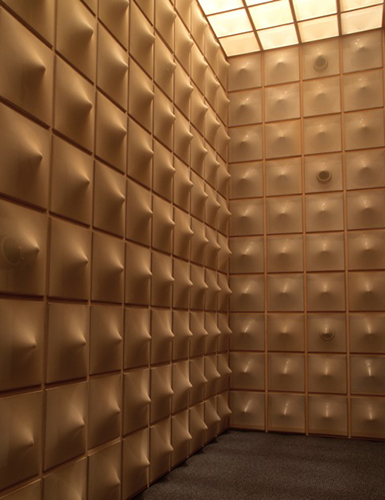
Sheer
What it means to "create"
Kobayashi: Earlier, you said that you start without knowing what's going to happen, but when you're actually in contact with reality, you don't really know what reality is. You don't really know what the beginning or the end is. So I think that Kasahara's work is close to that feeling, but on the other hand, it's also quite clear.
Kasahara : The methodology is clear. But when you want to show that things aren't clear, you need to at least make the methodology clear, otherwise the lack of clarity won't be conveyed... (laughs) It's a contradiction.

Kobayashi: But I think that's typical of you. I think that texture and the way you choose materials are very important to you. On the one hand, there are some clear aspects that you've pursued, but what emerges in the form of something is often quite abstract.
Kasahara : The sculptures in Offering are made from classical materials, but in fact I did not make any of them with my own hands, but I think that's a clear answer for me.
Kobayashi: Does that mean that's where Kasahara is located?
Kasahara : I wonder... But if I put any more of my own creativity into it, it would be like I was lying, so I think of this work as the result of me expressing myself to the best of my ability.
Kobayashi: I think it probably means that something has to be created in a fair way that involves all sorts of people.
Kasahara : Yes. I think it's something to do with my own sense of balance.
Kobayashi: I also do BlanClass, and I take action in various ways in opposition to the idea of letting works take on a life of their own without hesitation, or simply dividing up various genres. After all, there are systems in the art world as well.
Kasahara : It's true that when my name is mentioned as the artist's name, it becomes like a tag that ties the work together, and I've always felt uncomfortable about that. Even though I came up with the idea for the sculpture in "OFFERING," the metalworkers and woodworkers worked hard to make it, and the donation box that appears in the documentary photograph was made by someone whose name I don't know and who I've never met. In that sense, I think I have a strong sense of how far I should equate the circumstances surrounding myself and my work.
Kobayashi: There are some parts that you can't understand without actually seeing them, but I imagine that the coexistence of cases where they appear as documents for various reasons and the perspective that makes them valid within the field of art leads to the statement. So there is a little more complexity in the forms, for example erotic forms...
Kasahara : Yes, I think it is erotic even in its very minimalist form.
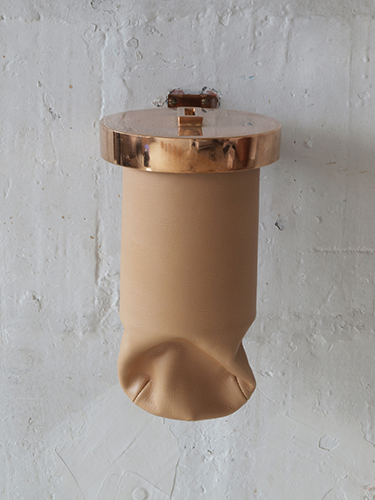
"Offering - Marna"
About the Yokohama Triennale 2014 Exhibition
Kasahara : At this year's Yokohama Triennale 2014, my work will be exhibited mainly at Shinko Pier (Shinko Pier Exhibition Facility) , but I am also exhibiting at the Yokohama Museum of Art. For example, my work will be placed behind Michael Landy's Art Bin, next to Warhol's "Climax Paintings," in front of Agnes Martin's work, and in front of Felix Gonzalez-Torres' work, and it is intended to be a collaboration with other works in the space, and how they are connected will become the meaning of the exhibition. And, people who have seen the exhibition at the Yokohama Museum of Art can come to Shinko Pier to see the documentary photographs and other sculptures.
Kobayashi: The sculptures will be exhibited mainly at the Yokohama Museum of Art.
Kasahara : There are some at Shinko Pier too, but the photographs are only there. There are actually 60 photographs in total, but due to space limitations, we are only exhibiting 40 of them this time.
Kobayashi: The actual works will be on display at the Yokohama Triennale 2014, which will be held soon, so I will leave it at that for now. Thank you for today.
Emiko Kasahara Homepage: http://www.emikokasahara.com
Edition WorksHP: http://urx.nu/aAiG
